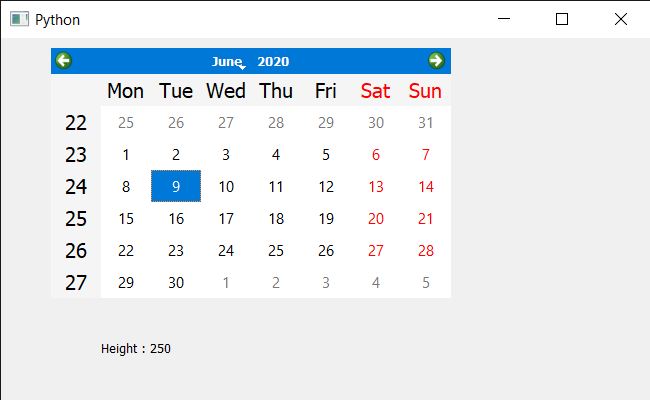En este artículo veremos cómo podemos obtener la altura del QCalendarWidget. Para obtener la propiedad de altura que usamos height, esta propiedad contiene la altura del widget excluyendo cualquier marco de ventana. De forma predeterminada, esta propiedad contiene un valor que depende de la plataforma del usuario y la geometría de la pantalla.
Para hacer esto, usaremos
heightel método con el objeto QCalendarWidget.Sintaxis: calendario.altura()
Argumento: no requiere argumento
Retorno: Devuelve entero
A continuación se muestra la implementación.
Python3
# importing libraries
from PyQt5.QtWidgets import *
from PyQt5 import QtCore, QtGui
from PyQt5.QtGui import *
from PyQt5.QtCore import *
import sys
class Window(QMainWindow):
def __init__(self):
super().__init__()
# setting title
self.setWindowTitle("Python ")
# setting geometry
self.setGeometry(100, 100, 650, 400)
# calling method
self.UiComponents()
# showing all the widgets
self.show()
# method for components
def UiComponents(self):
# creating a QCalendarWidget object
self.calendar = QCalendarWidget(self)
# setting geometry to the calendar
self.calendar.setGeometry(50, 10, 400, 250)
# setting cursor
self.calendar.setCursor(Qt.PointingHandCursor)
# format
format = QTextCharFormat()
format.setFont(QFont('Times', 12))
# setting header text format
self.calendar.setHeaderTextFormat(format)
# creating label to show the properties
self.label = QLabel(self)
# setting geometry to the label
self.label.setGeometry(100, 280, 250, 60)
# making label multi line
self.label.setWordWrap(True)
# getting height of the calendar
value = self.calendar.height()
# setting text to the label
self.label.setText("Height : " + str(value))
# create pyqt5 app
App = QApplication(sys.argv)
# create the instance of our Window
window = Window()
# start the app
sys.exit(App.exec())
Producción :
Publicación traducida automáticamente
Artículo escrito por rakshitarora y traducido por Barcelona Geeks. The original can be accessed here. Licence: CCBY-SA